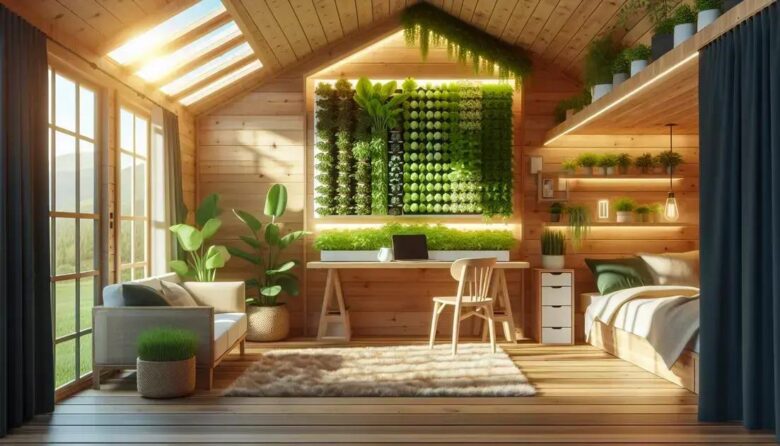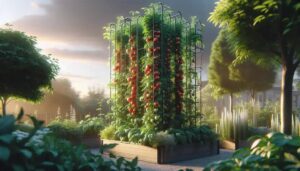Vertical gardens in tiny homes optimize space and enhance surroundings by using walls for greenery, integrating hydroponic systems, and maintaining sustainable practices, effectively transforming compact areas into lush, eco-friendly environments.
Planters and hydroponic vertical walls are a game changer for tiny homes, offering a sustainable way to bring greenery indoors. Ever thought about maximizing your small space with clever designs? Let’s dive into the world of vertical gardening and explore how it can revolutionize compact living!
why choose vertical planters for tiny homes
Vertical planters are a fantastic solution for tiny homes, maximizing space while adding greenery to your living area. These innovative systems not only enhance the aesthetic appeal of your home but also contribute to better air quality. Space is a premium in tiny homes, and vertical planters allow for effective use of vertical surfaces, turning any blank wall into a lively garden. They can be easily installed on balconies, kitchen walls, or even living room areas, bringing nature’s tranquility right into your home.
Efficient Use of Space
By growing plants vertically instead of horizontally, you can cultivate herbs, flowers, or even vegetables in tight spaces. This setup is perfect for urban dwellers who want to enjoy homegrown produce without the luxury of a garden.
Environmental Benefits
Vertical planting is a sustainable choice that supports local biodiversity and helps reduce your carbon footprint. Many options are available, from self-watering systems to designs made from recycled materials, allowing you to go green both literally and figuratively!
Overall, vertical planters are not just about saving space—they transform living environments into healthy, green sanctuaries that promote well-being and connectivity with nature.
integrating hydroponic systems in small spaces
Integrating hydroponic systems within small spaces can transform how you grow plants without soil, making it ideal for confined areas. Hydroponics uses nutrient-rich water to nourish plants, allowing for efficient space use and year-round gardening. Compact kits are available for indoor use, fitting easily on countertops or shelves. These systems not only save space but also conserve water, making them eco-friendly alternatives to traditional gardening.
Setting Up Your Hydroponic Garden
Begin by choosing a system that fits your space, such as a vertical tower or a tabletop unit. Ensure it allows for good light exposure, which is crucial for plant growth. LED grow lights can supplement natural light, helping plants thrive even in dimmer areas.
Choosing the Right Plants
Opt for plants that adapt well to hydroponics, such as lettuce, spinach, and herbs. These varieties are not only easy to handle but also quick-growing, providing fresh produce continuously.
Maintenance involves checking nutrient levels and water quality regularly. Modern systems come with automated features, reducing maintenance time and ensuring optimal plant health. This makes hydroponics a practical choice for busy urbanites looking to enjoy gardening without the mess of soil.
step-by-step guide to building a vertical wall
Building a vertical wall planter can be a rewarding project for any tiny home enthusiast. With the right tools and materials, you can construct a lush masterpiece in no time. Start by selecting an appropriate wall that receives adequate sunlight. Indoor walls that face south or west are often ideal.
Gather Your Materials
You’ll need a wooden or metal frame, planters or pockets for the plants, and a waterproof backing to protect your wall. Don’t forget the mounting hardware and tools like a drill, screws, and a level.
Constructing the Frame
Assemble your frame according to the chosen size, ensuring it is sturdy enough to hold the weight of the plants and soil. Secure it to the wall with appropriate anchors, checking that it is level and evenly positioned.
Next, attach the planters or pockets to the frame. You can use pots or fabric pockets depending on your design preference. Make sure they have drainage holes to prevent water accumulation.
Choosing and Planting
Select plants that thrive well in vertical settings, such as ferns, succulents, or herbs. Arrange them in a way that balances aesthetics and light needs. When planting, gently pack soil around the roots to ensure stability. Water the plants thoroughly.
With regular care, your vertical wall will become a lush feature in your tiny home, offering both practical and visual benefits.
boosting sustainability in micro environments
Boosting sustainability in micro environments is essential for eco-friendly living. Urban gardens and green walls are transformative elements in small spaces. These features contribute to cleaner air by absorbing pollutants and releasing oxygen, playing a crucial role in sustainability. Utilizing natural resources efficiently is key to creating a more sustainable lifestyle.
Energy Efficiency
Incorporating energy-efficient technologies, like LED lighting and solar panels, can drastically reduce energy consumption. These technologies are adaptable to small areas, making them suitable for tiny homes or urban apartments.
Water Conservation
Implementing water-saving techniques such as rainwater harvesting and drip irrigation systems helps in conserving water. These methods ensure that water use is optimized, which is vital for sustainability in micro environments.
Plant Selection
Choosing native plants or drought-resistant varieties reduces the need for excessive watering. These plants are adapted to local climates and require less maintenance, further enhancing sustainability.
With thoughtful planning and implementation, even the smallest spaces can become models of sustainability, contributing to a healthier planet.
creative ideas for plant selection and design
Choosing the right plants and designing your space creatively can transform any area into a green oasis. Start by considering plant characteristics like size, color, and growth pattern. Mixing different textures and hues can add depth and interest to your garden.
Color Coordination
Pairing plants with complementary or contrasting colors enhances the visual appeal. For example, combine the dark foliage of hostas with the bright petals of marigolds. This contrast can make your garden pop.
Vertical and Horizontal Layers
Integrate vertical elements like climbing plants or trellises to use space effectively. Layer shorter plants at the front and taller ones at the back. This creates a tiered effect, making the most of both horizontal and vertical space.
Functional and Decorative Plants
Incorporate aromatic herbs like lavender or basil that add function and fragrance. These plants serve dual purposes, offering both culinary uses and ornamental beauty.
By thoughtfully selecting plants and designing with creativity, you can craft a vibrant garden that is both practical and picturesque.
maintaining your vertical garden efficiently
Maintaining a vertical garden efficiently ensures healthy plant growth and a vibrant display. Regular care is essential to keep your plants thriving and your setup functioning optimally. Watering is crucial, as vertical gardens can dry out faster than traditional gardens. Consider using a drip irrigation system to provide consistent moisture.
Regular Pruning
Trimming plants regularly encourages healthy growth and prevents over-crowding. Remove any dead or yellow leaves and keep vines neatly trimmed to maintain the garden’s appearance.
Pest Control
Inspect your garden for any signs of pests or diseases. Using organic pesticides or introducing beneficial insects like ladybugs can help manage unwanted visitors without harmful chemicals.
Fertilization is important because nutrients can leach quickly from vertical setups. Use water-soluble fertilizers to feed plants bi-weekly, ensuring they receive the necessary nutrients.
Checking structural integrity regularly is also vital. Ensure that the mounting hardware is secure and that the wall and frame are stable, especially if heavy plants are involved.
Unlocking the Potential of Vertical Gardens in Tiny Homes
Bringing vertical gardens into your tiny home offers a multitude of benefits, from improving air quality to adding visual charm. By carefully selecting plants and efficient designs, even the smallest spaces can become lush paradises. Utilizing hydroponic systems, vertical planters, and creative plant arrangements not only beautifies your home but also boosts sustainability and resource efficiency.
Regular maintenance and thoughtful planning ensure that your vertical garden thrives throughout the seasons. Embracing these strategies can transform micro environments into thriving green spaces, offering a unique blend of beauty and functionality.
Explore the endless possibilities with vertical gardens and let your tiny home become a testament to innovation and eco-friendly living.
FAQ – Frequently Asked Questions about Vertical Gardens in Tiny Homes
What are the benefits of having a vertical garden in a tiny home?
Vertical gardens maximize limited space, improve air quality, and add aesthetic value, making tiny homes feel more vibrant and livable.
How do hydroponic systems work in small spaces?
Hydroponic systems use nutrient-rich water instead of soil, allowing for efficient plant growth in compact areas.
What plants are best suited for vertical gardens?
Plants like ferns, succulents, herbs, and small vegetables thrive well in vertical gardens due to their adaptable nature.
How often should I maintain my vertical garden?
Regular maintenance, including watering, pruning, and pest control, is crucial and should be done weekly for optimal plant health.
Can vertical gardens help with sustainability?
Yes, they promote sustainability by improving air quality, conserving water, and utilizing eco-friendly materials.
What is the cost associated with installing a vertical garden?
The cost varies based on size and design but can range from affordable DIY projects to more expensive custom installations.



